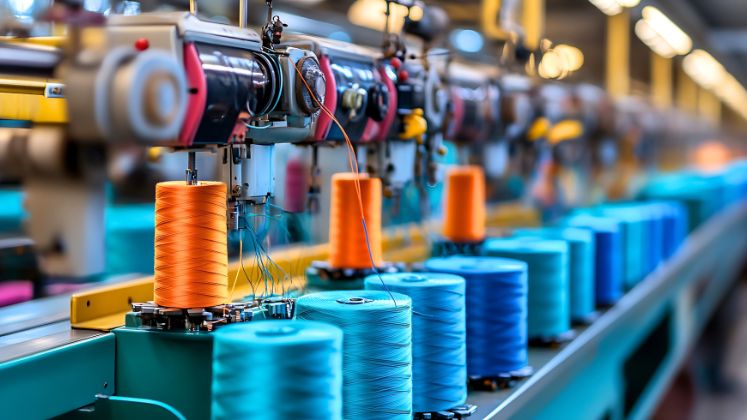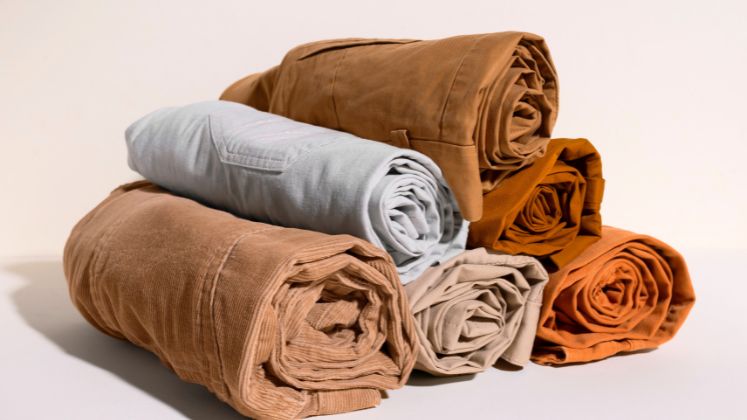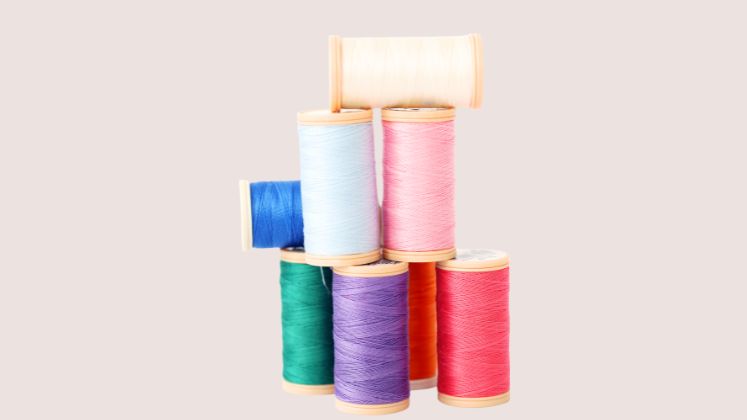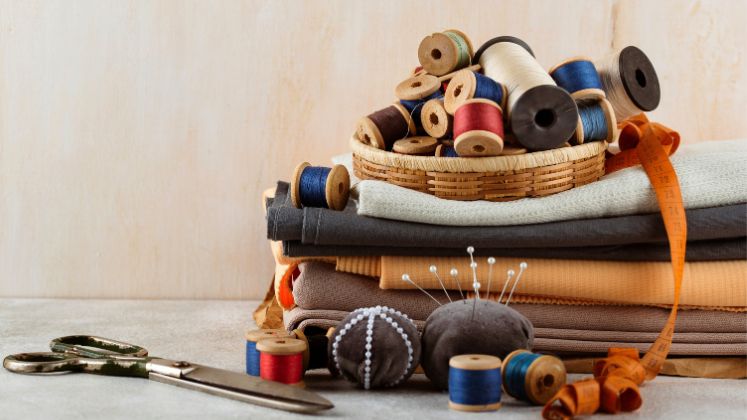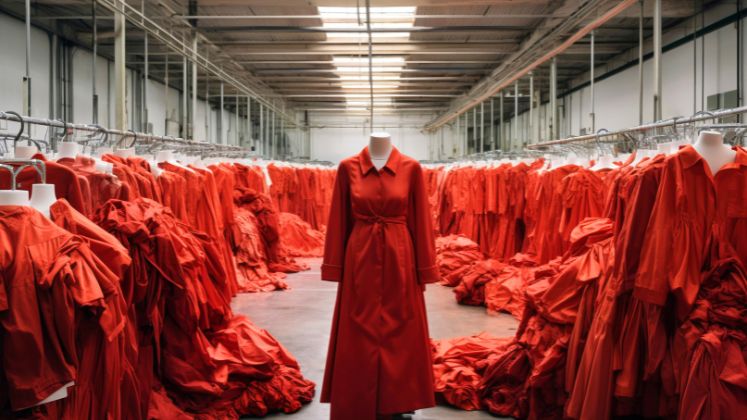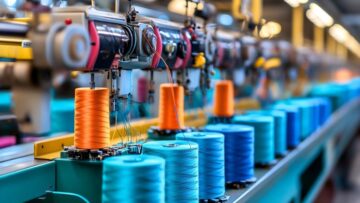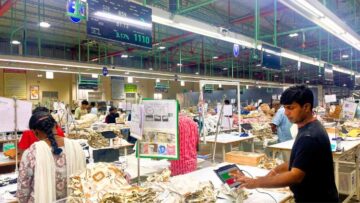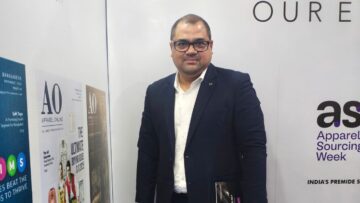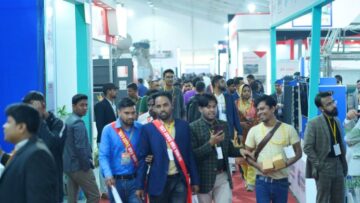For far too long, the RMG sector has taken centre stage, and rightfully so, given the massive revenue it generates. To maximise growth, there’s been a strong push to diversify the export basket and explore higher-value product categories. But amidst all this, the low-hanging fruit—the textile and accessories sector—has been largely overlooked. It’s time to change that! And boosting these sectors can also give a big lift to the RMG industry itself.
The textile market alone is set to hit US $ 8 billion by 2025, growing at a CAGR of 3.77 per cent from 2025-29. The value-added margin is projected at 40 per cent and despite some domestic challenges, the potential is huge!
| US $ 1 billion
Home textiles, which includes items like carpets, rugs, curtains, bed linens and towels, has now become one of the top three sectors with over US $ 1 billion in exports, alongside jute and leather goods. |
Meanwhile, the Garments Accessories and Packaging (GAP) sector plays a crucial role as the backward linkage industry for RMG. In FY 2023-24, it brought in US $ 6.87 billion, including US $ 1 billion from direct exports, to markets like Netherlands, South Africa, India, the Middle East, Italy and more.
To hit the US $ 80 billion RMG export target by 2030, the GAP sector needs to generate US $ 12 billion—a huge but achievable goal.
Winning Strategies for Textile Companies in a Tough Market
More than 86 per cent of Bangladesh’s export earnings are coming from textiles and textile-related products. Investment in the Primary Textile Sector (PTS) is around US $ 22 billion. Moreover, the PTS is supplying 85-90 per cent of the yarn needed for knit RMG and 40-45 per cent of the yarn needed for woven RMG. It is also producing 7.5 billion metres of fabric locally to meet domestic demand, along with supplying yarn for handloom production.
Bangladesh’s home textile exports are bouncing back after nearly a year of decline. This recovery is mainly due to weaker local currency, more production capacity and a slight improvement in the gas supply. According to the EPB, home textile exports grew by 7.85 per cent from July to December this year, reaching US $ 410.81 million. This is a big improvement after a period of negative growth.
Home textiles, which includes items like carpets, rugs, curtains, bed linens and towels, has now become one of the top three sectors with over US $ 1 billion in exports, alongside jute and leather goods. December alone saw a strong growth of 20.47 per cent, with home textile exports reaching US $ 83.98 million.
In recent years, over nine million new spindles have been added. By the end of this year, another six million spindles are expected to be installed, with a goal of reaching 15 million.
Back in FY 2021, home textile exports crossed the US $ 1 billion mark, growing by an impressive 49.17 per cent year-on-year. The growth continued into the next year, rising by another 40 per cent to US $ 1.62 billion. But the gas crisis disrupted that trend, dropping exports to US $ 1.09 billion, nearly a third less.
To counter these challenges, Noman Group, one of Bangladesh’s largest textile manufacturers with production capacity across spinning, weaving, dyeing and finishing, has diversified its product range, expanded into new markets and optimised production efficiency.

“We are actively expanding our global footprint by exploring new product categories such as technical textiles and eco-friendly fabrics. We are also investing in direct-to-consumer models to strengthen our market position,” said Zubair Mohammad Abdullah, MD, Noman Group.
| Zubair Mohammad Abdullah, MD, Noman Group
“We are actively expanding our global footprint by exploring new product categories such as technical textiles and eco-friendly fabrics. We are also investing in direct-to-consumer models to strengthen our market position.” |
He added, “We foresee moderate growth in the textile sector, driven by increasing demand for performance textiles. Emerging markets in Africa and Latin America, along with premium segments in Europe and North America, present strong growth opportunities.”
The group produces 20,000 tonnes of towels, 150 million yards of fabric, 130 million yards of home textiles, 25 million yards of greige fabric and 1.1 million tonnes of yarn, with an annual revenue between US $ 1.2 billion to US $ 1.5 billion.

| M Saiful Islam Chowdhury, Chief Project Officer and Company Secretary, Envoy Textiles
“We source premium raw cotton from the US, African countries and the Middle East, ensuring the highest quality fibres. Since cotton is an agricultural product, its price varies based on harvesting conditions, global supply chains and economic trends. To mitigate price volatility, we maintain seasonal stock to ensure a stable supply.” |
“We source raw materials both locally and internationally, ensuring the highest quality at competitive prices. Cotton is procured from leading global suppliers, including the USA, India and African countries. Our sourcing strategy prioritises sustainability, cost efficiency and supply chain reliability, considering factors like fibre quality, price fluctuations and trade regulations,” highlighted Zubair Mohammad.
Talking about how Envoy Textiles, which claims to be the first denim mill in Bangladesh with rope dyeing technology, managed challenges, M Saiful Islam Chowdhury, Chief Project Officer and Company Secretary said, “Although the textile industry has been impacted by inflationary pressures and a global recession, the demand for denim remains stable, as there is no true alternative to denim except for variations in consumer purchasing power. With the global economy showing signs of recovery, we are optimistic about continued demand growth.”
The company produces 52 million yards of denim fabric every year and has a spinning capacity of 25,000 metric tonnes annually. Envoy Textiles is expanding, especially in blended yarn production. Its current project produces 4.5 metric tonnes of blended yarn daily and this capacity is expected to double in the coming years.
Highlighting their sourcing strategy, he added, “We source premium raw cotton from the US, African countries and the Middle East, ensuring the highest quality fibres. Since cotton is an agricultural product, its price varies based on harvesting conditions, global supply chains and economic trends. To mitigate price volatility, we maintain seasonal stock to ensure a stable supply.”
Babul, Senior GM, Marketing, Ha-Meem Group, is also optimistic about the future. “We currently have a four-month confirmed order booking, reflecting strong demand and customer trust in our high-quality yarn and fabric production,” he said.
| US $ 8 billion
Experts point out that with the global packaging market worth US $ 800 billion, capturing just 1 per cent could bring in US $ 8 billion in exports. Also, there’s even more untapped potential in emerging markets like Myanmar and African nations. |
Ha-Meem Group, one of the largest textile manufacturers in Bangladesh, specialises in denim, non-denim fabrics and spinning operations. The company produces 5.5 million yards of denim fabric per month and 2.5 million yards of non-denim fabric per month, with plans to expand production to 4 million yards per month. The company also plans to introduce printed and yarn-dyed fabric production within the next six months.
“We source 90 per cent of our cotton from the US, along with cotton from Indonesia and India,” explained Babul.
However, he pointed out growing competition from countries like Pakistan, which benefit from government support, zero-rated EU tariffs under the GSP+ scheme and a strong cotton harvest. Babul also suggested that if the government stockpiles cotton from global markets, it could help stabilise prices and offer more cost predictability to textile manufacturers.
Experts also recommend setting up a domestic chemical industry with easier regulations to reduce dependence on imports, which would lower production costs and make Bangladesh’s textile industry more competitive.
The Bangladesh Textile Mills Association (BTMA) has asked Finance Adviser Salehuddin Ahmed to stop yarn imports through the customs houses at land ports to protect the country’s textile industry. They suggest that yarn should be imported through seaports instead.
The trade body which represents Yarn and Fabric Manufacturers and Textile Product Processors pointed out that yarn and fabrics from India are being sold at very low prices in the local market through various land ports. They also mentioned that land ports like Benapole, Bhomra, Sona Masjid and Banglabandha don’t have the proper facilities, equipment to measure yarn, skilled workers or proper control by authorities, which is making trade difficult. The letter also stated that the rule allowing partial shipments for yarn imports is being misused. More yarn is being imported under the same letter of credit (LC) than what was actually approved and this is happening multiple times.
Thriving with Technology and Sustainability
The industry has realised that investing in technology and sustainability is the key to sustaining in this tough environment.
For example, to maintain superior quality, Noman Group uses advanced spinning, weaving and finishing technologies. They employ Rieter and Trützschler spinning machines for high-quality yarn production, Picanol and Toyota air-jet and rapier looms for precise weaving and Benninger and Monforts finishing machines for advanced fabric processing. They also use eco-friendly dyeing technology to reduce water and chemical usage.
“We use organic and recycled materials in our production, employ energy-efficient machinery to cut down on carbon emissions, recycle water, use eco-friendly dyeing processes to reduce waste and hold certifications like OEKO-TEX, GOTS and BCI to meet global sustainability standards,” stated Zubair Mohammad.

| Babul, Senior GM, Marketing, Ha-Meem Group
“We currently have a four-month confirmed order booking, reflecting strong demand and customer trust in our high-quality yarn and fabric production. We source 90 per cent of our cotton from the US, along with cotton from Indonesia and India.” |
Similarly, Envoy Textiles can collaborate with global R&D partners, including Spanish textile researchers, to enhance denim product development. Envoy also operates a dedicated in-house laboratory that focuses on developing cutting-edge fabric innovations. The company also operates a marketing office in Dhaka and maintains an international representative office in Hong Kong to strengthen its global presence. “To stay ahead, we leverage state-of-the-art spinning, weaving and finishing machinery, sourced from Europe, the US, Japan, Switzerland and Germany. We have also built a highly skilled international team, consisting of Turkish experts in operations and development, Indian professionals in production and a marketing team in the US,” explained M Saiful Islam.

| Md. Wasim Akram, DGM, Dekko Accessories
“Bangladesh’s trims industry is growing rapidly and we expect 2025 to bring even more positive changes. Orders that used to go to other countries are now coming back to Bangladesh, and products like metal buttons, plastic buttons, narrow fabrics and rubber, which were previously made in China, are now being produced here. Buyers are also developing new products within Bangladesh.” |
He also revealed that a solar energy project is in progress to reduce dependence on conventional power sources. Envoy is also replacing its existing generation system with brand-new, energy-efficient technology, ensuring a sustainable and cost-effective manufacturing process. Additionally, the company has initiated a waste fabric recycling project, which will enable the conversion of discarded textiles into new fibres. The LC for this project has already been opened and the launch is expected imminently.
Meanwhile, Ha-Meem Group recently hosted experts from Bangladesh University of Engineering and Technology (BUET) to explore the integration of AI and robotics into its manufacturing operations.
“We use advanced machinery for every stage of textile processing, including for warping, dyeing, weaving, singeing and finishing. Our dyeing process is powered by world-class machines from leading manufacturers such as Suker Müller (Germany), Can Korea (South Korea), Morrison (China) and Picanol (Belgium), guaranteeing superior fabric quality,” said Babul.
The group has also developed a denim recycling plant and is collaborating with Japanese brand Muji to meet strict standards for bamboo fibre spinning and fabric production, with a strong focus on recycling denim waste, developing sustainable bamboo fabrics and processing organic fibres like modal, Tencel and linen.
Accessories Industry Is Scaling Up
Bangladesh has more than 1,600 factories that produce garment accessories and packaging materials. Out of these, only 40 are big factories, each earning over US $ 30 million a year.
Many garment factories have also started making accessories. Mondol Group, a big clothing company, opened a factory called Montrims Limited. At least 50 other factories like Onus Group, Well Group, Babylon, KDS, Deco Group, Four Group, Sadma Fashion, Epyllion, Envoy Group and Designtex Group have also invested in making accessories.
These factories produce almost everything needed, including items like poly bags, neck boards, honeycomb cartons, back boards, tape, bar codes, zippers, tissue paper, elastic, labels, collar bones, interlining, draw-cords, embroidery, buttons, security tags, velcro tape, collar inserts, price tags, moulds, buckles, butterflies, hangers, RFID tags, sewing threads, gum tape, leather patches and more.
| “We have introduced a line of biodegradable buttons made from natural materials to cater to the growing demand for sustainable fashion. Currently, we are operating at approximately 70 per cent of our production capacity, focusing on maintaining high-quality standards.” Nazrul Islam Maruf, Owner, Goodwill Accessories |
Experts point out that with the global packaging market worth US $ 800 billion, capturing just 1 per cent could bring in US $ 8 billion in exports. Also, there’s even more untapped potential in emerging markets like Myanmar and African nations.
Of late, the accessories and packaging industry has seen a big boost in investments in radio frequency identification (RFID) technology. In the last five years, the number of local factories making RFID products has increased from 5-6 to 30, according to the Bangladesh Garments Accessories and Packaging Manufacturers and Exporters Association (BGAPMEA).
BGAPMEA President Md. Shahriar mentioned that over 100 factories are planning to invest in local RFID production, which could help boost both local manufacturing and exports.
“Companies are implementing RFID for tracking and supply chain transparency,” said Md. Wasim Akram, DGM, Dekko Accessories. The company manufactures a wide range of trims and accessories, including labelling, metal and plastic buttons, poly, narrow fabrics and other essential garment accessories.
He further said, “Bangladesh’s trims industry is growing rapidly and we expect 2025 to bring even more positive changes. Orders that used to go to other countries are now coming back to Bangladesh and products like metal buttons, plastic buttons, narrow fabrics and rubber, which were previously made in China, are now being produced here. Buyers are also developing new products within Bangladesh.”
He also mentioned that there’s a high demand for trims with certifications like BSCI, GOTS, LEED and hazardous material compliance. Dekko Accessories is implementing in-house recycling of poly and focusing on eco-friendly packaging.
“We have introduced a line of biodegradable buttons made from natural materials to cater to the growing demand for sustainable fashion,” pointed out Nazrul Islam Maruf, Owner, Goodwill Accessories.
The company specialises in manufacturing a wide range of trims and accessories. Its product line includes buttons, zippers, labels, hangtags, elastics and various decorative items.
“Currently, we are operating at approximately 70 per cent of our production capacity, focusing on maintaining high-quality standards,” said Nazrul Islam.
The company maintains high-quality standards through internationally recognised testing requirements and certifications such as OEKO-TEX, ISO 9001 and the Trim Qualification Program (TQP).
| 15 million
In recent years, over nine million new spindles have been added. By the end of this year, another six million spindles are expected to be installed, with a goal of reaching 15 million. |
“We have started using an ERP system to improve our technology and are looking at India as a new market,” said Golam Mainul Hassan, Senior Manager of Marketing and Merchandising, Al Muslim Garments Accessories Ltd. The company produces over 2.5 million clothing items every month for kids, men and women, earning over US $ 200 million a year. It also makes accessories like tags, twill tapes and laces.
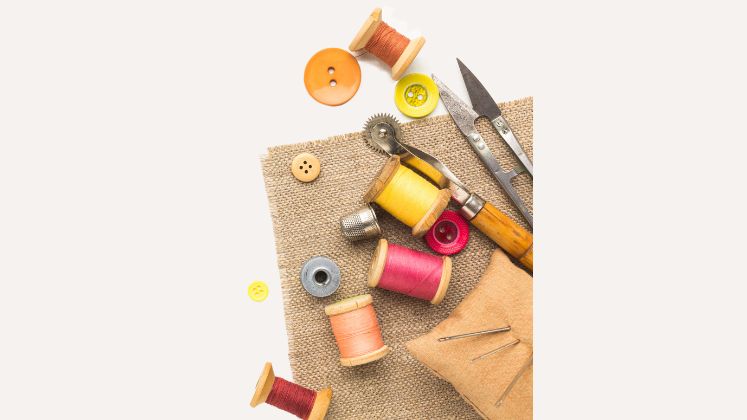 Manufacturers reiterated that due to tensions between China and the USA, some companies are now looking at Bangladesh for partnership opportunities.
Manufacturers reiterated that due to tensions between China and the USA, some companies are now looking at Bangladesh for partnership opportunities.
Experts believe that giving the sector direct exporter status and offering more policy support could help it grab a bigger piece of the global market.
Md. Shahriar mentioned that an agreement with the Korean Packaging Federation is being worked out to help Bangladeshi manufacturers work with Korean companies. This will focus on direct exports, sharing technology, joint projects and investments.
However, to reach its full potential, the industry needs to overcome certain challenges. Small and medium-sized manufacturers struggle to obtain foreign currency letters of credit, forcing them to buy dollars at higher off-market rates. The government must stabilise energy supplies, improve factory security and create a more favourable investment environment. Additionally, small factories face high-interest rates of up to 16 per cent, while larger companies enjoy slightly lower rates, making competition even tougher.
Experts reiterated that with innovation, sustainability, strategic investments and right government support, Bangladesh’s textile and accessories sector is poised for solid growth!
(With inputs from Iffat Ara Munia)

